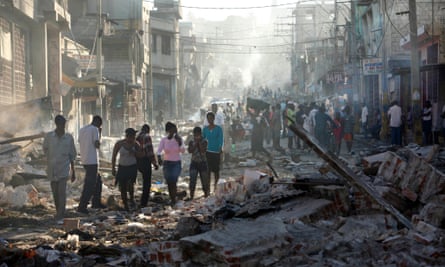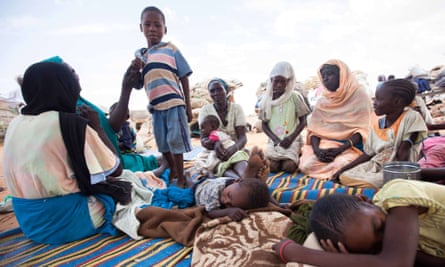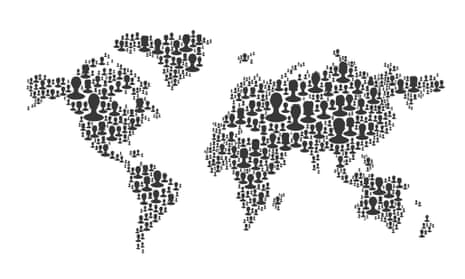In the past, if you wanted to help out in times of tragedy you might travel to disaster zones or volunteer with a charity. But with the growth of online campaigning, the internet appears to offer the opportunity to change the world without leaving your lounge.
From Facebook to games and viral pop songs, digital initiatives reassure us that we don’t need to look up from our laptops or phones to help others in their time of need.
There’s even a virtual pet, Argi the intergalactic goat explorer, to help fundraising efforts to combat Ebola.
Videos encouraging us to help, or better, to share the link, are ubiquitous: Beyoncé’s I Was Here video racked up 17m views for World Humanitarian Day and the message was simple, if vague: do something good. It’s still unclear what the viral ALS ice bucket challenge really accomplished – but it certainly wasn’t lacking in popularity.
But the embrace of technology in the fight to save lives is not without its problems.
Westerners trying to help poor, suffering countries have often been accused of having a “white saviour complex”: a term tied up in colonial history where Europeans descended to “civilise” the African continent.
In a series of tweets that went viral in 2012 following the #Kony2012 campaign, Nigerian writer Teju Cole describes the phenomenon: “The White Saviour Industrial Complex is not about justice. It is about having a big emotional experience that validates privilege.”
With the prevalence of campaigns, apps and games calling on us to help without really putting ourselves out, it seems that the white saviour idea is still alive and well – but now, the mode is digital.
Showing our best side
Using terms like digital samaritan or even “digital jedi”, a new book by Patrick Meier on humanitarianism in the internet age is a rousing manifesto urging readers not to feel alone or worthless; to go ahead and “like” something on Facebook. He even suggests that technology “can amplify our humanity”.
In Digital Humanitarians: How Big Data is Changing the Face of Humanitarian Response, Meier writes: “Anyone can be a digital humanitarian, absolutely no experience necessary; all you need is a big heart and access to the internet,” he claims.

This apparent ease of access – and pain-free form of aid work – is reflected in various apps helping us to do good without really putting ourselves out. Take for example Instead, an app which describes itself as a “micro donations, macro impact” tool, which tries to encourage users to change daily habits by pointing out how much impact this could have. “In lieu of your regular store-bought coffee, those few dollars could provide a South Sudanese child with clean water for a year,” it says.
Or, Donate a Photo, which claims to have “harnessed our relentless photo-sharing mania and turned it into something for the greater good”. For every photo you share through their platform, they donate $1 to a cause of your choice. Another application makes sure that each time you’re having drinks at happy hour, part of your money can be spent getting clean water to someone, somehow, somewhere... elsewhere.
In fact, the “politics of elsewhere” is being perfected to the point that users can make a difference without being burdened by any of the gory details.
Humanitarianism can also, apparently, be fun: Wikipedia lists 23 humanitarian games aimed at raising awareness among youth and children. The Red Cross has shown special initiative, and has this year signed a partnership with video game developer Bohemia Interactive.
But by turning humanitarianism into a popular activity, important issues risk entering the realm of the banal. Spending time updating Facebook profiles, liking posts and pages, using apps where you choose from a list of worthy causes, and composing the perfect tweet shifts the attention towards self-presentation, and glosses over the realities of the pain and suffering elsewhere.
It becomes more about a desire to show our best, most humanitarian side, and turns into a display of superficial solidarity rather than a deep engagement with the cause.
But is this a problem if people are really being helped?
Likes don’t save lives

For starters, technology is not neutral. Uncritically embracing the idea of the digital saviour masks important issues: who controls the technology? Who stands to benefit from it? Who profits?
The particular kind of neutrality associated with digital humanitarianism is dangerous: to be so detached from the cause you claim to support – and to spread information without quite asking what it really means, and who is behind it – is deeply problematic when you are dealing with human life.
Campaigns of the kind we’re now well used to emerged with Save Darfur, which began in 2004. At first, it utilised postcards, phone-a-thons, sit-ins, church groups, rallies and campus organisations, but its reach grew enormously when it embraced technology.
By 2007, Save Darfur had gone fully digital. It became the world’s largest Facebook campaign at the time, and released a video game – Darfur is Dying. It cleverly used numbers and big data, glossy images, and targeted young people – key characteristics that we now take to be the norm in large-scale crisis campaigns.
But research by the University of California found that among members of the Facebook group the vast majority in fact gave no money, and recruited no one.
The report concluded that “in the case of the Save Darfur campaign, Facebook conjured an illusion of activism rather than facilitating the real thing”.
Digital resistance
With the rise of the digital saviour, resistance has grown too, generating debate about the politics of digital activism.
The viral #Kony2012 campaign – which has attracted more than 100m views on YouTube – also gave birth to a resistance to it. Viewers began to more readily question whether the campaign – and others like it – might do more harm than good. Prominent writers argued that the film unintentionally highlighted western nonchalance in the depiction of African issues.
Talk show hosts, bloggers and comedians were unsparing. On Warscapes, Ethiopian-American novelist Dinaw Mengestu wrote: “What makes Kony 2012 especially frustrating, however, is that the film traffics in a sentimental and infantilising version of Africa that is so prevalent we don’t even notice it.”
Writer Teju Cole’s seven tweets in response, which captured much of the unease around Invisible Children’s representation of Uganda.
1- From Sachs to Kristof to Invisible Children to TED, the fastest growth industry in the US is the White Savior Industrial Complex.
— Teju Cole (@tejucole) March 8, 2012
5- The White Savior Industrial Complex is not about justice. It is about having a big emotional experience that validates privilege.
— Teju Cole (@tejucole) March 8, 2012
More recently, Michelle Obama’s 2014 tweet holding up the hashtag #BringBackOurGirls following the kidnapping of more than 200 young women in Chibok, Nigeria was met with some criticism. Can a hashtag really help? Similarly, outcry over CBS’s 60 Minutes programme and its Ebola coverage showed parts of the global community have grown intolerant to misguided or easy presentations of people from “other” places.
Our prayers are with the missing Nigerian girls and their families. It's time to #BringBackOurGirls. -mo pic.twitter.com/glDKDotJRt
— The First Lady (@FLOTUS) May 7, 2014
There are, of course, compelling examples where digital tools have been used to supplement – and circumvent – clunky government and NGO aid networks. The mobilisation of the Nepali diaspora following the 7.3 magnitude earthquake on 25 April, is a good recent example.
While all these methods can radically alter the nature of emergency relief, it’s important to make a distinction between meaningful campaigns for help and change, and humanitarianism that fuels prejudiced or stereotypical representations of non-western places.
For now, all I can say is: don’t retweet this without reading it first.
Bhakti Shringarpure is assistant professor of English at University of Connecticut and editor-in-chief of Warscapes magazine. You can follow her on Twitter @bhakti_shringa
A version of this article originally appeared on Warscapes, part of the Guardian Africa network

Comments (…)
Sign in or create your Guardian account to join the discussion